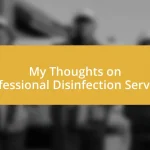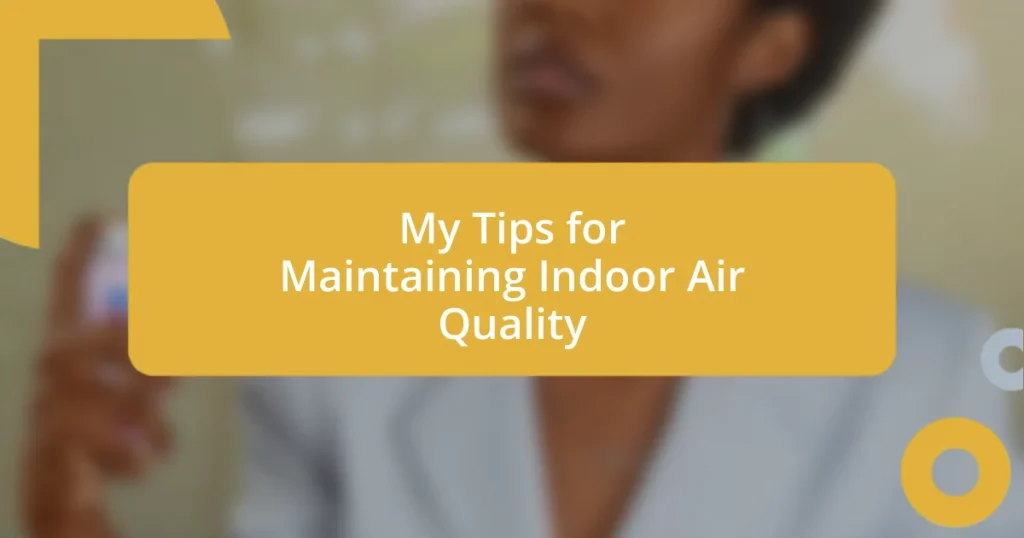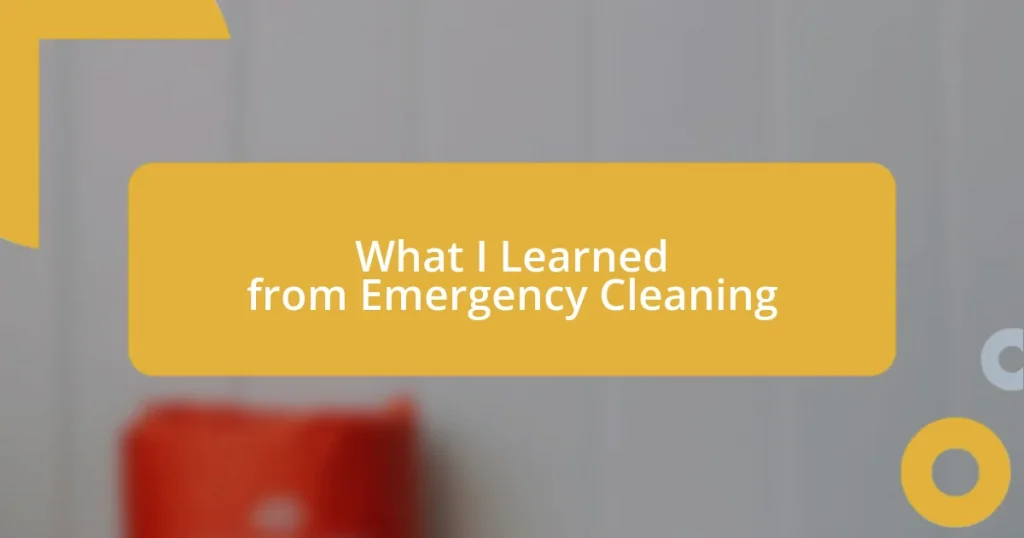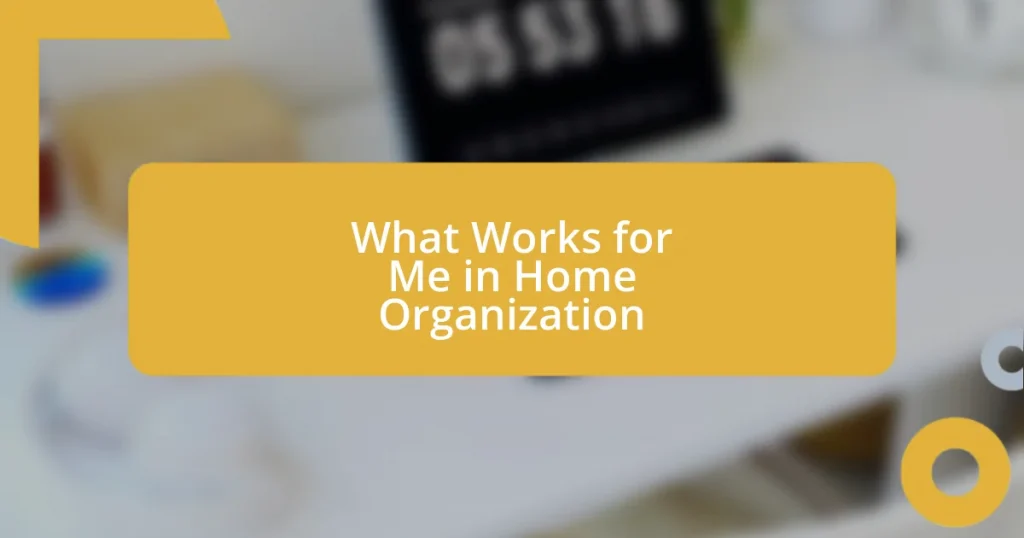Key takeaways:
- Eco-friendly pest control is not just about using non-toxic products; it focuses on creating a balanced ecosystem through natural methods like companion planting and introducing beneficial insects.
- Transitioning to eco-friendly practices led to notable benefits, such as improved indoor air quality, safety for children and pets, and long-term sustainability through natural pest deterrence.
- Implementing preventative measures, like crop rotation and habitat creation for beneficial insects, transformed gardening from a chore into a rewarding experience connected to nature.
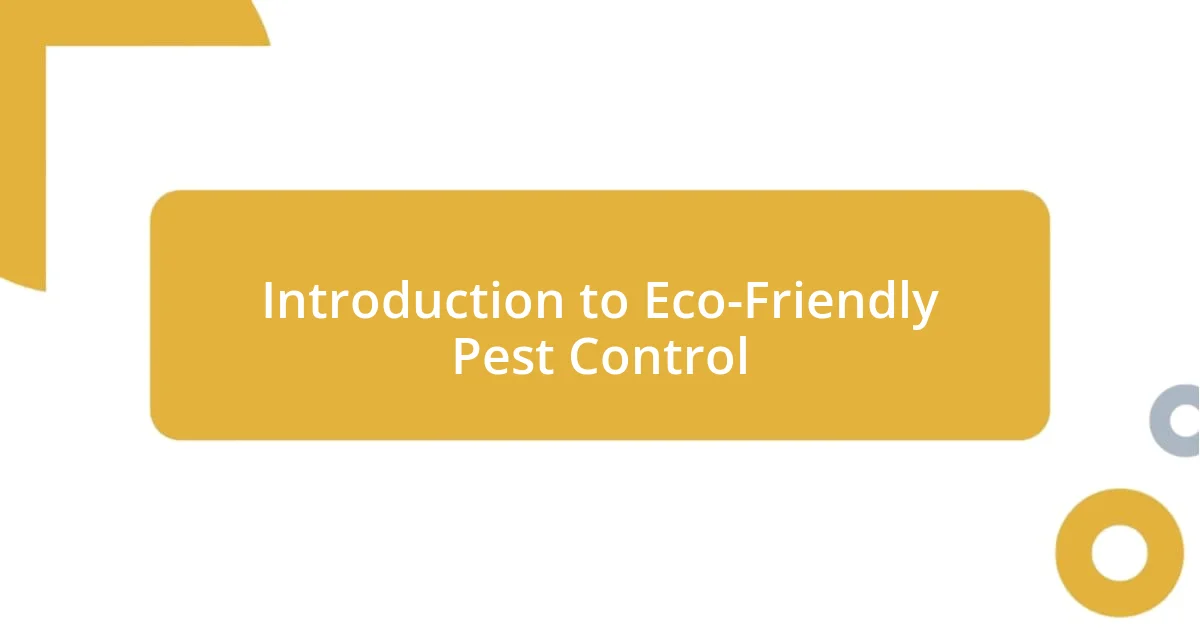
Introduction to Eco-Friendly Pest Control
When I first stumbled upon the concept of eco-friendly pest control, I was both skeptical and intrigued. How could something so natural effectively tackle the pesky intruders that often invade our homes? This curiosity led me on a journey where I discovered that eco-friendly methods can be surprisingly powerful while assuring me that I’m not harming the planet.
As I delved deeper into this approach, I realized that eco-friendly pest control isn’t just about using non-toxic products. It’s also about fostering a balanced ecosystem. For instance, I remember setting up a simple barrier of marigolds in my garden, which not only deterred pests but also attracted beneficial insects. Surprisingly, the success of this method gave me a sense of accomplishment and connection to nature that I hadn’t anticipated.
I find it essential for anyone considering this path to ask themselves whether they’re ready to embrace a holistic perspective on pest management. Is it worth exploring alternatives that protect both our homes and the environment, even if it means sometimes waiting a little longer for effective results? In my experience, the patience and mindfulness this approach entails can lead to much more favorable outcomes.

Benefits of Eco-Friendly Pest Control
When I transitioned to eco-friendly pest control, the immediate benefits struck me. Not only did I feel a sense of relief knowing I was using less harmful substances around my home, but I also noticed a revitalization of my garden. Colors seemed brighter and the air felt cleaner. It was as if the plants thrived with a newfound vigor, contributing to a more vibrant living space.
Here are some key benefits I’ve encountered with eco-friendly pest control:
-
Healthier Indoor Air Quality: Traditional pest control products can release harmful chemicals. By opting for eco-friendly solutions, I noticed a significant improvement in air quality, making my home feel fresher.
-
Safety for Children and Pets: Knowing that my kids and pets could safely roam around without the risk of exposure to toxic chemicals was a massive relief for me.
-
Long-Term Sustainability: Not only did my plants flourish, but the methods I employed helped cultivate a balanced ecosystem that deters pests naturally over time.
Switching to eco-friendly approaches also offered me a greater understanding of nature’s balance. I remember being amazed by how introducing a few ladybugs into my garden drastically reduced aphid populations. It’s these little victories that have encouraged me to lean into more natural methods, knowing that I am nurturing the environment while protecting my home.

Common Eco-Friendly Pest Control Methods
When I started exploring eco-friendly pest control methods, one of the first techniques I encountered was the use of essential oils. This approach seemed almost too good to be true—natural scents that not only smelled delightful but also deterred pests. I remember mixing peppermint oil with water in a spray bottle, and to my surprise, it worked wonders on spiders and ants. The aroma filled my home, creating a pleasant atmosphere while keeping those unwanted guests at bay.
Another effective method I’ve tried is introducing beneficial insects, such as ladybugs and praying mantises, into my garden. These little creatures not only added a whimsical touch to my plants but also played a crucial role in keeping harmful insects in check. I would often catch myself observing them at work, feeling a sense of joy and satisfaction as they engaged in their natural pest control duties. It reiterated for me the importance of working with nature rather than against it.
Finally, physical barriers, such as row covers or diatomaceous earth, are practical solutions I’ve implemented. These options are excellent for organically keeping pests off my vegetables and flowers. I remember one summer when I used diatomaceous earth; it was almost a game to sprinkle it around my plants and watch the pests disappear. This hands-on experience not only fostered my connection to gardening but also provided peace of mind knowing my food was safe from harmful chemicals.
| Method | Description |
|---|---|
| Essential Oils | Using natural oils, like peppermint, in a spray to repel pests while leaving a pleasant scent. |
| Beneficial Insects | Introducing insects like ladybugs to naturally control pest populations in gardens. |
| Physical Barriers | Implementing barriers such as row covers or diatomaceous earth to prevent pests from accessing plants. |
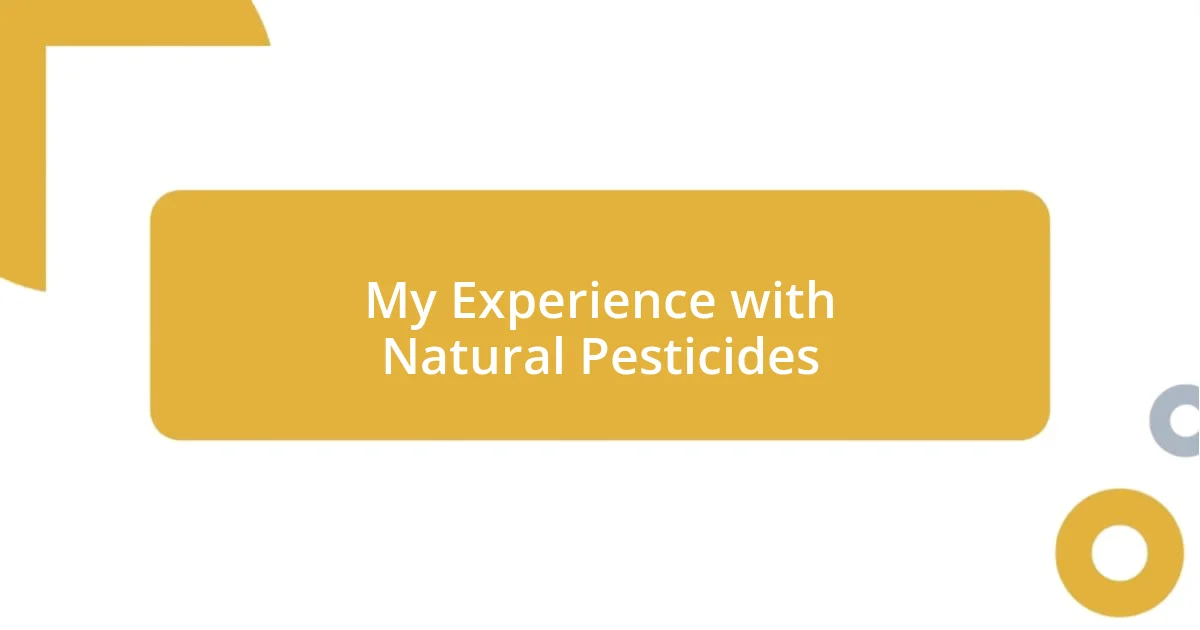
My Experience with Natural Pesticides
I began experimenting with natural pesticides out of sheer curiosity. I remember the first time I used neem oil—an ancient remedy derived from the seeds of the neem tree. As I diluted it with water and sprayed it on my plants, I felt a wave of hope. Would this truly keep the pests away without harming my precious garden? To my delight, not only did it fend off the pesky moths, but it also seemed to enhance the overall health of my plants. That moment solidified my belief in the power of nature.
So, what about homemade solutions? I couldn’t resist trying a garlic spray one day, inspired by a gardener friend’s recommendation. I ventured into my kitchen, blending garlic cloves with water and letting it steep overnight. The following day, I sprayed it on my vegetable garden, chuckling to myself at the idea of ridding my cherished tomatoes of pests with something so simple. The scent was pungent, and while it was a bit overwhelming for me, it worked like a charm. The aphids vanished, leaving my tomatoes unscathed. It was such a rewarding experience, watching my favorite plants thrive again.
In my journey with natural pesticides, I also embraced companion planting. One sunny afternoon, I planted marigolds among my vegetables, excited about their natural pest-repellent properties. As I watered the garden, I couldn’t help but feel I was orchestrating a symphony—every plant playing its part. It was a revelation! I began to see gardening not merely as a chore but as a collaboration with nature, as each plant supported the others. This realization truly transformed my approach, making me a more mindful and engaged gardener. Have you ever underestimated the simple beauty of nature working in harmony? I know I did until I embraced these methods.
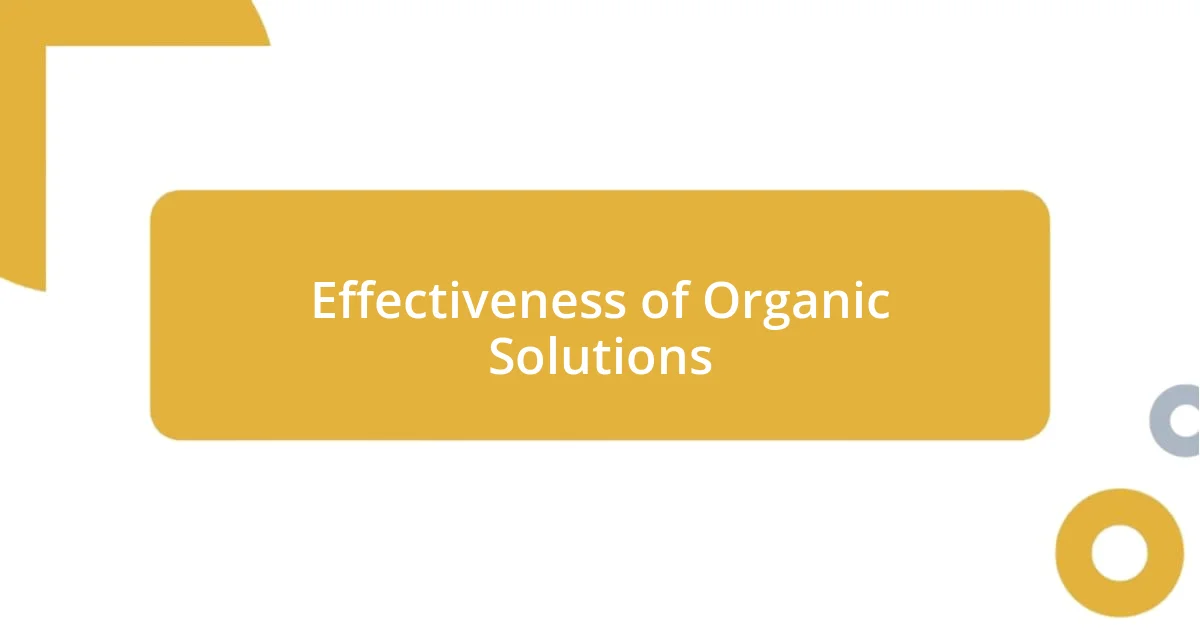
Effectiveness of Organic Solutions
Using organic solutions has truly reshaped my gardening experience, revealing their surprising effectiveness. I still remember the first time I sprinkled diatomaceous earth around my plants like a protective cloak. At first, I was skeptical—could this fine powder really deter pests? The next day, I checked in on my garden, and to my amazement, I found fewer critters munching on my tomatoes. It felt like I had discovered a hidden treasure that allowed me to protect my plants while staying true to my eco-friendly principles.
Another instance that stands out is when I introduced beneficial insects into my garden. One sunny afternoon, I released a small batch of ladybugs, just as a friend had suggested. Watching those little beetles embark on their mission was genuinely delightful. It was fascinating to see how quickly they took to their role as nature’s own pest controllers. I couldn’t help but feel a sense of wonder—wasn’t it remarkable that such tiny allies could make such a significant impact on my garden’s health?
And let’s talk about the essential oils! I had this moment of disbelief as I mixed eucalyptus oil with water, thinking it might just smell nice. As I began to spray it around, a sense of hope washed over me. Would this really keep those persistent ants away? To my delight, it did! The refreshing scent lingered in the air, transforming my space while also guarding it against uninvited guests. Have you ever experienced that blend of freshness and effectiveness in your own gardening? It’s a unique satisfaction that I am determined to nurture as I continue my journey with these organic solutions.

Tips for Implementing Eco-Friendly Practices
When I first decided to embrace eco-friendly pest control, I focused on preventative measures in my garden. I started by rotating my crops, which, interestingly enough, made me feel like I was giving my soil a chance to breathe and rejuvenate. By changing up where I planted each season, I noticed a significant drop in pest populations. Have you ever noticed how a simple change in routine can lead to surprising benefits? It’s like gardening taught me a new way to connect with the ecosystem around me.
Creating a habitat for beneficial insects was another game-changer. I remember planting diverse flowers like yarrow and alyssum, which I now see as little beacons for pollinators and pest predators. Watching butterflies flutter and ladybugs munch away has brought me pure joy. It’s remarkable how inviting nature into your garden can lead to a thriving ecosystem. Isn’t it amazing to think that a vibrant garden can become a sanctuary for those helpful critters?
Lastly, maintaining a clean garden space proved crucial for implementing eco-friendly practices. By regularly removing debris and fallen fruit, I realized how much this simple task prevented potential pest infestations. I used to view weeding as a chore, but now, I see it as an act of love for my plants. This shift in mindset transformed my gardening routine into something fulfilling. Isn’t it true that a little care can go a long way in nurturing life? It’s an inspiring reminder of how we can make a positive impact with conscious choices.








